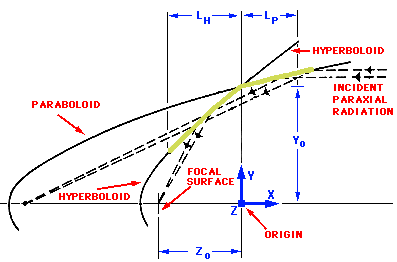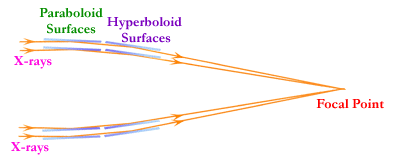ASTROSAT Soft X-ray imaging Telescope Optics:
1. X-ray focussing
Telescope optics at soft X-ray bands employ grazing incidence
reflection from metal surfaces. The refractive index of metals
in X-rays is slightly less than one so it is possible to get a total
external reflection at a vacuum-metal interface if the X-rays
are incident nearly parallel to the metal surface.
The limiting angle of
grazing incidence lies between a few degrees at ~0.1 keV to a few
arcminutes at ~10 keV.
Sections of paraboloidal surfaces, far from their apex, can be
configured to focus soft X-rays via grazing incidence. However,
this arrangement strongly violates the
Abbe sine condition
and the images in the focal plane seriously suffer from
Coma.
This can be
remedied by including a second reflection, for example from a
hyperboloidal surface, as displayed below. This is known as
the Wolter-I optical arrangement, and has been adopted in most
of the focussing X-ray telescopes flown to date.

Wolter-I imaging principle
As only a degree
or so in angle from each surface is in effective use, it is
possible to nest such surfaces within one another, with a common
focus, to increase the collecting area.

Example of Nesting
2. Foil Optics
While the Wolter-I optics provides excellent imaging quality, the
production and maintenance of the accurate paraboloidal-hyperboloidal
surfaces is very expensive and require thick, heavy mirror substrate.
This also limits the number of nested surfaces that can be
accommodated to just a few.
An alternative that has emerged over the past decade is to
approximate the paraboloid and the hyperboloid by conical surfaces
that are tangent to them. This sacrifices the image quality somewhat,
the resulting point spread function being of order an arcminute.
However, one can produce these conical surfaces using thin,
lightweight foils, and nest a large number of such foils to achieve
a large collecting area. The SXT optics on ASTROSAT has adopted
this design. Two separate mirror blocks are needed, one to replace
the parabolic section (called the 1-alpha section) and the other
to replace the hyperbolic one (called the 3-alpha section). These
two blocks are then accurately aligned into the final mirror assembly.
3. ASTROSAT SXT mirrors

A schematic of the ASTROSAT SXT reflector assembly. The upper
half consists of the 1-alpha section foil mirrors and the
lower half the 3-alpha section.
|
ASTROSAT SXT mirrors are made of 10 cm long shaped conical shells of
0.2 mm thick Aluminium. Each foil is coated with 20-50 micron
thick epoxy and on it is deposited a 1400 Angstrom thick layer of
Gold which acts as the reflecting surface. Each shell is made of
four quadrant segments, and there are 41 such nested shells in both
1-alpha and 3-alpha sections, thus requiring a total of
41x8=328 foils. Some of the basic parameters of the mirror
assembly are:
| Focal Length |
: |
2000 mm |
| Max. foil radius |
: |
130 mm |
| Min. foil radius |
: |
65 mm |
| Reflector length |
: |
100 mm |
| Min. reflector spacing |
: |
0.5 mm |
|

|
|
SXT foil mounting arrangement (detail)
|



















